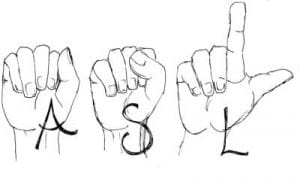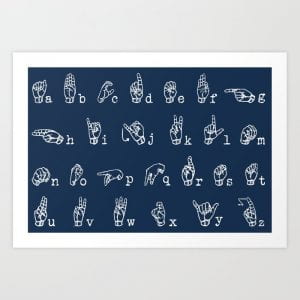In-depth blog post #3
Since my last blog post, I have learned more about ASL grammar and a few new signs. My mentor, Sandra, taught me how to fingerspell names with double letters. There are three ways to sign double letters: bouncing your hand when signing, keeping you hand still, or moving your hand sideways when signing the double letter. All the letters are signed in one of these three ways. For example, the letter “B” is signed by bouncing your hand, while the letter “M” is signed without a bounce. “A”, “O”, and “E” are all signed by moving your hand to the side when fingerspelling that letter. I must remember which method of signing is used for each letter, which is difficult at times, but I will continue to practice. I also learned how to ask different types of questions, and how to respond properly using the ASL grammar and facial expressions. Sandra is such an amazing mentor and I am so excited to continue learning ASL with her!
What went particularly well during my mentoring sessions?
In the sessions I have had so far with my mentor, a few things that went particularly well were our ability to communicate, the rate at which I was learning, and creating a good environment to learn. Even though neither of us were talking, as Sandra is Deaf, we were able to effectively exchange questions and concepts. Sandra always brings papers to our meetings with information on what I am going to learn, and she writes little notes on the paper to clarify if necessary. To learn a new sign or concept, Sandra demonstrates and then gets me to repeat it. Because a huge part of ASL is body language, we communicate using facial expressions just as much as we communicate through sign. It is a really interesting and different experience! Sandra also teaches me a lot each week but gives me time to practice and ask questions. She gives me sheets for me to practice at home before meeting her again each week, so I feel that I am learning a lot, without it being too much of an overload of information. I always feel comfortable at the meetings to ask questions or to get Sandra to repeat something, which creates a positive environment for learning.
What learning challenges emerged and what did I do to hold myself accountable for my learning?
A large learning challenge that emerged was communicating more complex conversations without an interpreter. For the first meeting I had with Sandra, another woman came and interpreted our conversations so that we could establish questions like how long we were going to meet for and where. For all the meeting after that, though, it was just Sandra and me. Weirdly, I find that I learn faster without an interpreter because I am forced to pay extra attention to signs and facial expressions. But when Sandra is showing me something more complex or trying to correct me, sometimes things are miscommunicated when we are just relying on ASL. Another challenge that emerged is trying to keep up with the conversation when we are fingerspelling because I still find it difficult to quickly recognize and comprehend what she is saying. To stay accountable for my learning, I make sure to practice the sheets that Sandra gives me at each meeting so that I improve before the next time we meet. I also go back to the things that I learned a few meetings ago to make sure I do not forget information I already learned. I make sure to watch videos on the two sites Sandra recommended to review signs.
What logical challenges affected our communication and what factors affected our ability to interact effectively?
The obvious answer to this question is the fact that Sandra and I cannot communicate verbally. Although I am slowly figuring out how to communicate using ASL, I am not used to relying so heavily on facial expressions. Body language is a large part of ASL, and Sandra says that ASL is 40% signs and 60% body language. Also, when we speak out loud, we can hear the tone of someone’s voice to detect their emotions. With my mentor, I cannot hear her tone, and this is something that affects our ability to communicate. Even with these obstacles, we are still able to find ways to communicate our ideas, either by fingerspelling out words, using body language or, when absolutely necessary, writing things down.
I cannot wait to keep learning ASL with Sandra!

